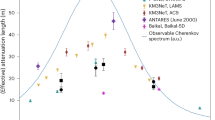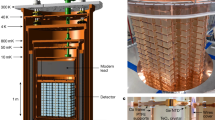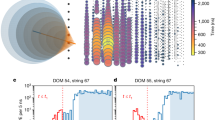Abstract
Neutrinos are elementary particles that carry no electric charge and have little mass. As they interact only weakly with other particles, they can penetrate enormous amounts of matter, and therefore have the potential to directly convey astrophysical information from the edge of the Universe and from deep inside the most cataclysmic high-energy regions1. The neutrino's great penetrating power, however, also makes this particle difficult to detect. Underground detectors have observed low-energy neutrinos from the Sun and a nearby supernova2, as well as neutrinos generated in the Earth's atmosphere. But the very low fluxes of high-energy neutrinos from cosmic sources can be observed only by much larger, expandable detectors in, for example, deep water3,4 or ice5. Here we report the detection of upwardly propagating atmospheric neutrinos by the ice-based Antarctic muon and neutrino detector array (AMANDA). These results establish a technology with which to build a kilometre-scale neutrino observatory necessary for astrophysical observations1.
This is a preview of subscription content, access via your institution
Access options
Subscribe to this journal
Receive 51 print issues and online access
$199.00 per year
only $3.90 per issue
Buy this article
- Purchase on Springer Link
- Instant access to full article PDF
Prices may be subject to local taxes which are calculated during checkout




Similar content being viewed by others
References
Gaisser, T. K., Halzen, F. & Stanev, T. Particle physics with high-energy neutrinos. Phys. Rep. 258, 173–236 (1995).
Totsuka, Y. Neutrino astronomy. Rep. Prog. Phys. 55, 377–430 (1992).
Roberts, A. The birth of high-energy neutrino astronomy: A personal history of the DUMAND project. Rev. Mod. Phys. 64, 259–312 (1992).
Balkanov, V. A. et al. An upper limit on the diffuse flux of high energy neutrinos obtained with the Baikal detector NT-96. Astropart. Phys. 14, 61–67 (2000).
Lowder, D. M. et al. Observation of muons using the polar ice as a Čerenkov detector. Nature 353, 331–333 (1991).
Andres, E. et al. The AMANDA neutrino telescope: Principle of operation and first results. Astropart. Phys. 13, 1–20 (2000).
Waxman, E. & Bahcall, J. N. High-energy neutrinos from cosmological gamma ray burst fireballs. Phys. Rev. Lett. 78, 2992–2295 (1997).
Askjeber, P. et al. Optical properties of the south pole ice at depths between 0.8 and 1 km. Science 267, 1147–1150 (1995).
Price, B. P. Implications of optical properties of ocean, lake, and ice for ultrahigh-energy neutrino detection. Appl. Opt. 36, 1965–1975 (1997).
Wischnewski, R. et al. in Proc. 26th Int. Cosmic Ray Conf., Salt Lake City 2 (eds Kieda, D., Salamon, M. & Dingus, B.) 229–232 (1999).
Dalberg, E. et al. in Proc. 26th Int. Cosmic Ray Conf., Salt Lake City 2 (eds Kieda, D., Salamon, M. & Dingus, B.) 348–351 (1999).
Bay, R. et al. in Proc. 26th Int. Cosmic Ray Conf., Salt Lake City 2 (eds Kieda, D., Salamon, M. & Dingus, B.) 225–228 (1999).
Niessen, P. et al. in Proc. 26th Int. Cosmic Ray Conf., Salt Lake City 2 (eds Kieda, D., Salamon, M. & Dingus, B.) 344–347 (1999).
Learned, J. G. & Mannheim, K. High-energy neutrino astrophysics. Ann. Rev. Nucl. Sci. 50, 679–749 (2000).
Szabo, A. P. & Protheroe, R. J. Implications of particle acceleration in active galactic nuclei for cosmic rays and high-energy neutrino astronomy. Astropart. Phys. 2, 375–392 (1994).
Stecker, F. W. & Salamon, M. H. High-energy neutrinos from quasars. Space Sci. Rev. 75, 341–355 (1996).
Nellen, L., Mannheim, K. & Biermann, P. L. Neutrino production through hadronic cascades in AGN accretion disks. Phys. Rev. D 47, 5270–5274 (1993).
Mannheim, K., Protheroe, R. J. & Rachen, J. P. Cosmic ray bound for models of extragalactic neutrino production. Phys. Rev. D 63, 023003-1–023003-16 (2001).
Waxman, E. & Bahcall, J. N. High energy neutrinos from astrophysical sources. An upper bound. Phys. Rev. D 59, 023002-1–023002-8 (1999).
Fukuda, Y. et al. (Super-Kamiokande Collaboration) Measurement of the flux and zenith-angle distribution of upward through-going muons by Super-Kamiokande. Phys. Rev. Lett. 82, 2644–2648 (1999).
Acknowledgements
This research was supported by the following agencies: US National Science Foundation, Office of Polar Programs; US National Science Foundation, Physics Division; University of Wisconsin Alumni Research Foundation; US Department of Energy; Swedish Natural Science Research Council; Swedish Polar Research Secretariat; Knut and Allice Wallenberg Foundation, Sweden; German Ministry for Education and Research; US National Energy Research Scientific Computing Center (supported by the Office of Energy Research of the US Department of Energy); UC-Irvine AENEAS Supercomputer Facility; Deutsche Forschungsgemeinschaft (DFG). D.F.C. acknowledges the support of the NSF CAREER programme and C.P.d.l.H. acknowledges support from the European Union 4th Framework of Training and Mobility of Researchers.
Author information
Authors and Affiliations
Corresponding author
Rights and permissions
About this article
Cite this article
Andrés, E., Askebjer, P., Bai, X. et al. Observation of high-energy neutrinos using Čerenkov detectors embedded deep in Antarctic ice. Nature 410, 441–443 (2001). https://doi.org/10.1038/35068509
Received:
Accepted:
Issue Date:
DOI: https://doi.org/10.1038/35068509
This article is cited by
-
Highly cited Antarctic articles using Science Citation Index Expanded: a bibliometric analysis
Scientometrics (2016)
-
Astronomy in Antarctica
The Astronomy and Astrophysics Review (2010)
-
Effects of charged Higgs bosons in the deep inelastic process ν τ N → τ − X and the possibility of detecting tau-neutrinos at cosmic neutrino detectors
Pramana (2008)
-
Cosmic neutrinos from the sources of galactic and extragalactic cosmic rays
Astrophysics and Space Science (2007)
Comments
By submitting a comment you agree to abide by our Terms and Community Guidelines. If you find something abusive or that does not comply with our terms or guidelines please flag it as inappropriate.



